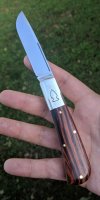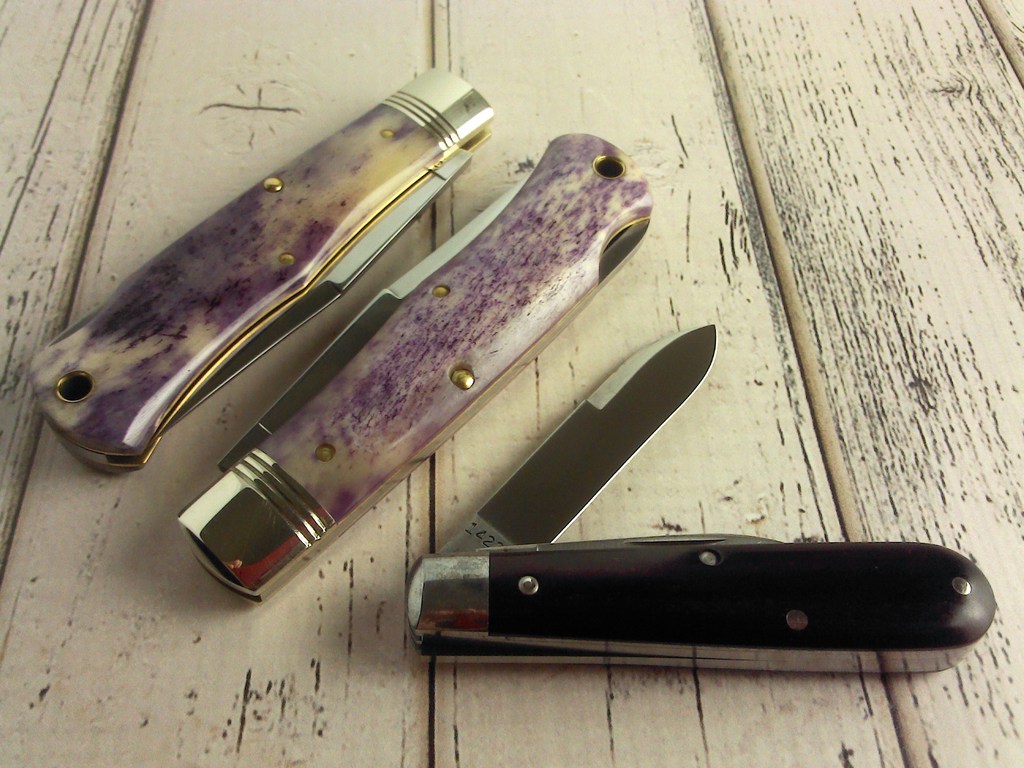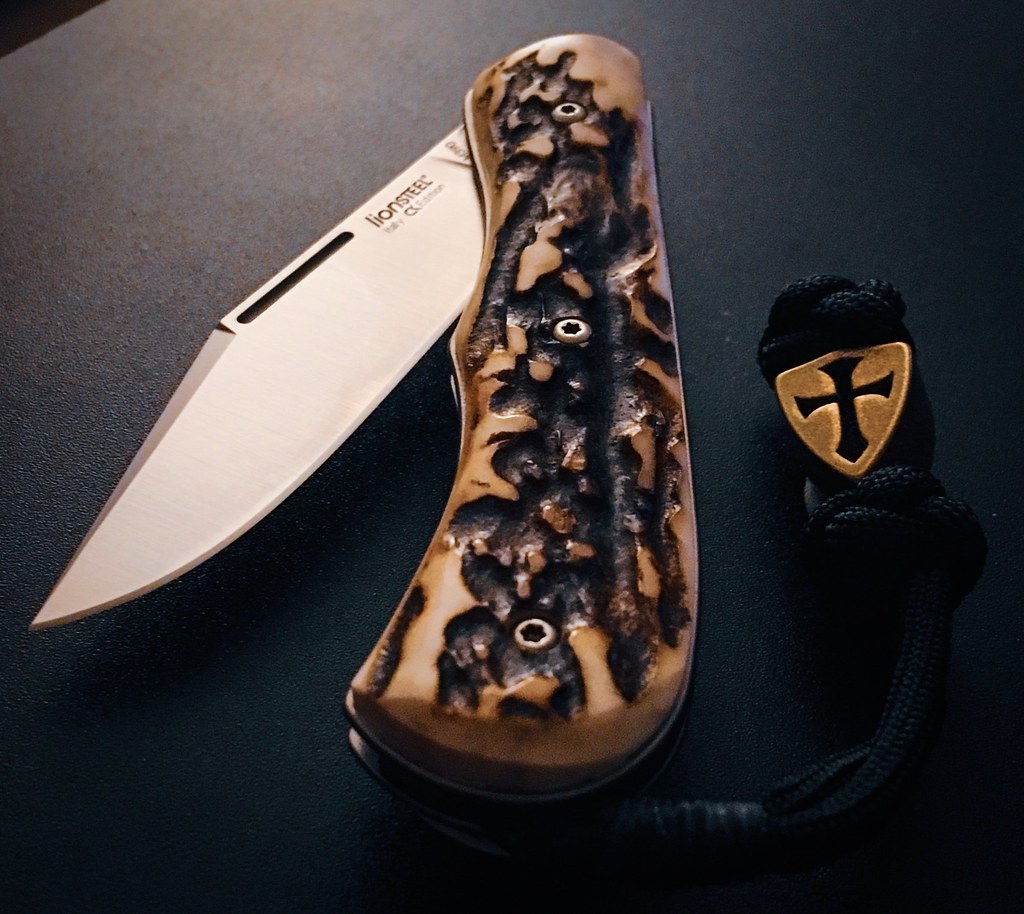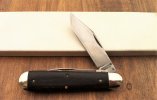-
The BladeForums.com 2024 Traditional Knife is available! Price is $250 ea (shipped within CONUS).
Order here: https://www.bladeforums.com/help/2024-traditional/
You are using an out of date browser. It may not display this or other websites correctly.
You should upgrade or use an alternative browser.
You should upgrade or use an alternative browser.
What "Traditional Knife" are ya totin' today?
- Thread starter jackknife
- Start date
- Joined
- Feb 6, 2014
- Messages
- 10,774
Out of all the knives you’ve posted Stuart that is one of the most unusual/appealing yet. Is it an exercise in design or does the dual guard have a purpose such as for a fighting knife? Either way it’s stunning.Thanks, Nick. I have no idea as to the maker. That's a problem inherent in inheriting knives with no accompanying documentation. the tang marks shown are all the ID that I have. I have several knives, folders and fixed blade, from that maker, and have posted a few in the Customs forum for help identifying the maker without much success. Such as this Elmer Keith pattern hunter:



- Stuart
- Joined
- Sep 5, 2013
- Messages
- 2,552
Buzzbait
Gold Member
- Joined
- Feb 25, 2001
- Messages
- 6,810
Outstanding cocobolo!!!
Old Engineer
Gold Member
- Joined
- Nov 30, 2014
- Messages
- 10,086
Carrying these 2 today :
Taylors Eye Witness



And a C. Lutters LOEWEN MESSER ( Lions Knife )


It looks like some previous owner hammered on the spine edge of the blade and tried to cut through a nail . You can not see the damage to the spine , but I certainly can feel it .
Both of these knives really take an edge .
Harry
Taylors Eye Witness



And a C. Lutters LOEWEN MESSER ( Lions Knife )


It looks like some previous owner hammered on the spine edge of the blade and tried to cut through a nail . You can not see the damage to the spine , but I certainly can feel it .
Both of these knives really take an edge .
Harry
Gary W. Graley
“Imagination is more important than knowledge"
Knifemaker / Craftsman / Service Provider
- Joined
- Mar 2, 1999
- Messages
- 27,787
315
Gold Member
- Joined
- Dec 2, 2017
- Messages
- 7,085
Camillus #69, #99 and a Hess Tiburon for a Hike with the dog.


I’ve thought about picking up a Hess Tiburon with a leather handle but wondered if the blade might be a bit large for a hunting knife. Your thoughts?
I'm taking a break from the frontier today and toting this 881 I got recently.
View attachment 1059617
I love the 881 and wouldn’t hesitate to put any knife up for a day to carry one!!
Fodderwing
Gold Member
- Joined
- Jan 31, 2017
- Messages
- 9,182
Thank you Stuart.That SW is stunning, Dwight
That is too good!You just need a little culinary help, Dwight
Wonderful knives Stuart. Especially the most unusual fixed blade. That gentleman had a special touch of artistic genius.Such as this Elmer Keith pattern hunter:
Out of all the knives you’ve posted Stuart that is one of the most unusual/appealing yet. Is it an exercise in design or does the dual guard have a purpose such as for a fighting knife? Either way it’s stunning.
Wonderful knives Stuart. Especially the most unusual fixed blade. That gentleman had a special touch of artistic genius.
Elmer Keith (1889-1984) was a rancher (Salmon, Idaho), firearms innovator and renowned shooter, and writer. He wrote for numerous magazines (e.g., Guns and Ammo) and wrote numerous books on firearms, hunting, and Western life. He was, particularly, a handgunner and was instrumental in the development of the .357, .44, and , .41 magnum rounds (and the guns to fire them). He was reported have put down a running rifle-wounded deer at 600 yards with a .44 mag revolver. He liked Stetsons and cigars.
In 1964, knife maker Gil Hibben made a hunting knife for his buddy, Mr. Keith, for his big game forays. The blade is 5/16" thick at spine and down to the bevel. It is flat-topped to allow a hunter to baton the blade through a moose/elk joint/pelvis with a tree limb/rock. The front of the guard has obvious benefits for butchering large animals, and the rear "hook" is intended to allow the hunter to hang the knife on a finger or belt loop while working on the carcass.
I hunt smaller game and use a less "industrial" knife, but I admire this one, its history, and its namesake.
- Stuart
- Joined
- Feb 6, 2014
- Messages
- 10,774
Thanks for that Stuart. I've read much about Elmer Keith but it's always nice to see something with a real practical use. As to that shot, even with cataract surgery I doubt I could see the target let alone hit it.Elmer Keith (1889-1984) was a rancher (Salmon, Idaho), firearms innovator and renowned shooter, and writer. He wrote for numerous magazines (e.g., Guns and Ammo) and wrote numerous books on firearms, hunting, and Western life. He was, particularly, a handgunner and was instrumental in the development of the .357, .44, and , .41 magnum rounds (and the guns to fire them). He was reported have put down a running rifle-wounded deer at 600 yards with a .44 mag revolver. He liked Stetsons and cigars.
In 1964, knife maker Gil Hibben made a hunting knife for his buddy, Mr. Keith, for his big game forays. The blade is 5/16" thick at spine and down to the bevel. It is flat-topped to allow a hunter to baton the blade through a moose/elk joint/pelvis with a tree limb/rock. The front of the guard has obvious benefits for butchering large animals, and the rear "hook" is intended to allow the hunter to hang the knife on a finger or belt loop while working on the carcass.
I hunt smaller game and use a less "industrial" knife, but I admire this one, its history, and its namesake.
- Stuart
- Joined
- May 20, 2018
- Messages
- 13,666
Elmer Keith was quite a man. I remember reading about the long range revolver shooting. Very impressive. And a good writer.Elmer Keith (1889-1984) was a rancher (Salmon, Idaho), firearms innovator and renowned shooter, and writer. He wrote for numerous magazines (e.g., Guns and Ammo) and wrote numerous books on firearms, hunting, and Western life. He was, particularly, a handgunner and was instrumental in the development of the .357, .44, and , .41 magnum rounds (and the guns to fire them). He was reported have put down a running rifle-wounded deer at 600 yards with a .44 mag revolver. He liked Stetsons and cigars.
In 1964, knife maker Gil Hibben made a hunting knife for his buddy, Mr. Keith, for his big game forays. The blade is 5/16" thick at spine and down to the bevel. It is flat-topped to allow a hunter to baton the blade through a moose/elk joint/pelvis with a tree limb/rock. The front of the guard has obvious benefits for butchering large animals, and the rear "hook" is intended to allow the hunter to hang the knife on a finger or belt loop while working on the carcass.
I hunt smaller game and use a less "industrial" knife, but I admire this one, its history, and its namesake.
- Stuart
mitch4ging
Gold Member
- Joined
- Jun 16, 2015
- Messages
- 11,267
Both great knives, but the covers on the Eye Witness are wonderful!Carrying these 2 today :
Taylors Eye Witness
And a C. Lutters LOEWEN MESSER ( Lions Knife )
It looks like some previous owner hammered on the spine edge of the blade and tried to cut through a nail . You can not see the damage to the spine , but I certainly can feel it .
Both of these knives really take an edge .
Harry
Will Power
Gold Member
- Joined
- Jan 18, 2007
- Messages
- 33,621
A modest RR today but I like it and the split back construction is nothing to moan about either


- Joined
- Dec 2, 2005
- Messages
- 71,200
Morning folks  Carrying these two today
Carrying these two today 









 Untitled
Untitled




